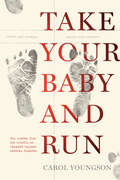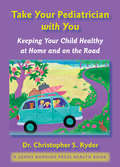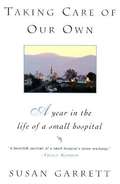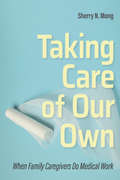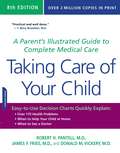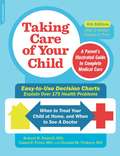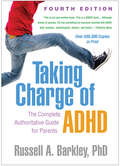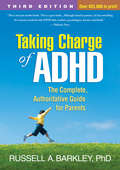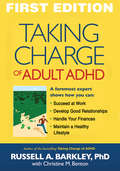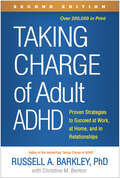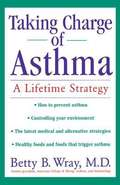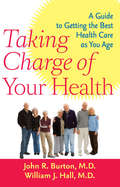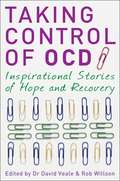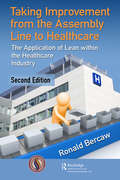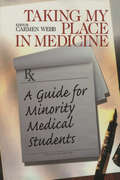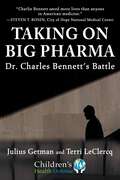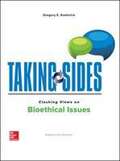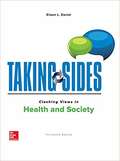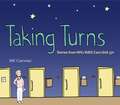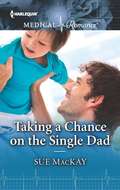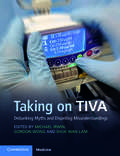- Table View
- List View
Take My Hand: The Caregiver’s Journey
by Tia Amdurer Chris Renaud-CogswellTake My Hand is a welcome, practical guide for the emotional journey of caregiving.The caregiver’s twisting and emotional journey is often bittersweet, combining feelings of exhaustion, reflection, love, frustration, delight, denial, connection, and loneliness. Just as they have taken on hand-holding for a loved one who needs multi-faceted support, many caregivers understandably feel overwhelmed and find themselves wishing for someone to guide them. Take My Hand is that resource. Written by Tia Amdurer, a Licensed Professional Counselor with a background in hospice, bereavement, grief, and loss, Take My Hand is structured into stand-alone chapters that can serve as a practical guide while navigating the different aspects of care for a loved one during the final years. Within each chapter are the witty, insightful, and heartfelt commentaries from Chris Renaud-Cogswell, penned as she took on the role of caregiver for her parents. Pages for note-taking and journaling are formatted to encourage self-reflection along the way.
Take My Hand: The inspiring and unforgettable BBC Between the Covers Book Club pick
by Dolen Perkins-Valdez'Shot through with spirit and hope, it's one hell of a book' Stylist, Books You Can't Miss in 2022Montgomery, Alabama. 1973. Fresh out of nursing school, Civil Townsend has big plans to make a difference in her community. At the Montgomery Family Planning Clinic, she intends to help women make their own choices for their lives and bodies.But when her first week on the job takes her down a dusty country road to a tumbledown cabin, she's surprised to find that her new patients are just eleven and thirteen years old. Neither of the Williams sisters has even kissed a boy, but they are poor and Black, and for those handling their welfare benefits, that's reason enough to have the girls on birth control. As Civil grapples with her new responsibilities, she takes India and Erica into her heart and comes to care for their family as though they were her own. But one day she arrives at their door to discover the unthinkable has happened, and nothing will ever be the same.Inspired by true events and a shocking chapter of American history, Take My Hand is a novel that will open your eyes and break your heart. An unforgettable story about love and courage, sisterhood and solidarity, it is also a timely and hopeful reminder that it only takes one person to change the world.
Take Your Baby And Run: How nurses blew the whistle on Canada’s biggest cardiac disaster
by Carol YoungsonForeword by Lanette Siragusa, RN NM Take Your Baby and Run is Carol Youngson's first-hand account of the shocking ineptitude and misogynistic behaviour that led to the death of twelve children, primarily infants, under the care of Dr. Jonah Odim at Winnipeg's largest hospital in 1994. Youngson was the nurse in charge of the cardiac unit and in her book she details the dysfunctional hospital hierarchy that allowed this tragedy to unfold, leading to the longest running inquiry in Canadian history. Sadly, the themes of this book are just as relevant today during our current health crisis.
Take Your Pediatrician with You: Keeping Your Child Healthy at Home and on the Road (A Johns Hopkins Press Health Book)
by Christopher S. RyderNamed One of the Best Consumer Health Books of 2007 by Library JournalIt's three o'clock in the morning and your child is screaming in pain. To make matters worse, you and your family are vacationing in a strange city. What should you do? Call the front desk? Your family pediatrician? An ambulance?From in-flight earaches to strep throat, from poison ivy to insect bites, illness and injury are common and unwelcome traveling companions. You need to know when to treat your child yourself and when to seek professional medical care. This compact handbook tells you how to decide and then puts crucial information for preventing and treating acute childhood illnesses and injuries at your fingertips. In Take Your Pediatrician with You, Dr. Christopher Ryder offers expert advice on keeping children safe and healthy at home and on the road. He includes detailed instructions for creating a children's medical care kit to use at home or while traveling. Also included are descriptions of common childhood illnesses and summer woes; travel tips; accident prevention; and guidelines for emergency care. A chapter on international adoption guides parents through the process of bringing a child home safely. As well as a reassuring travel companion, this valuable resource will become the "turn-to" guide at home and in childcare centers.
Taking A Career Break For Dummies
by Katrina McGheeTaking a career timeout could be the window of opportunity you’ve been looking for Taking A Career Break For Dummies shows you that a career break could be life-changing. Career breaks give us a chance to pause to identify opportunities and dreams, focus on the things we’ve been missing, and develop new skills. This book empowers you to take the leap into your next chapter. There are dozens of reasons you might want to do it, but whatever your circumstance, this friendly Dummies guide will help you value your own well-being, give yourself permission to grow and explore, and reclaim your time, your life, and your happiness. Develop your plan for taking a break from your career and for transitioning back when you’re ready Set a budget for your break, create a realistic timeline, and make it happen Access practical tools and resources to help you on your career break journey Build a positive mindset so you can enjoy your break and return to your career feeling renewedFor anyone looking for a new direction, feeling burned out, or longing to reignite that inner spark, Taking a Career Break For Dummies is a must. If you’re looking for help structuring your planned time off, you’ll also love the hands-on guidance and examples inside.
Taking Care of Our Own: A Year in the Life of a Small Hospital
by Susan GarrettGarrett's compelling depiction of the hospital in York, Maine, that she administered for six years becomes her occasion to examine what she terms the "fix" today's medical practitioners find themselves in. Noting that market competition has not contained medical costs, she shows us the turf battles within the system as her not-for-profit hospital attempts to reinvent itself to survive. What services should be added to compete in the hospital marketplace? Contract for a traveling CAT scanner owned by a for-profit firm? Institute a cardiology lab, a market niche? The 79-bed, 80-year-old York Hospital is vexed by its perceived mandate to take care of its own. Along with the affluent summer folk, the hospital's "neighbors" include the likes of homeless Tim Bailey, who turns up with chest pains each Christmas Eve and is hospitalized so he needn't be alone for the holidays; Elizabeth Littlejohn, a 19-year-old bulimic with a hospital bill of $76,000, who defaults on her $10 monthly payments and whose dirt-poor family has looked to York Hospital for social services for three generations. As Garrett ruminates on what hospitals should contribute to their communities, she vivifies the daily happenings at her own. And if she doesn't have ready answers, Garrett, who is now a freelance writer, makes us ponder the price of valuing too highly the cold logic of cost-benefit analysis.
Taking Care of Our Own: When Family Caregivers Do Medical Work (The Culture and Politics of Health Care Work)
by Sherry N. MongMixing personal history, interviewee voices, and academic theory from the fields of care work, the sociology of work, medical sociology, and nursing, Taking Care of Our Own introduces us to the hidden world of family caregivers. Using a multidimensional approach, Sherry N. Mong seeks to understand and analyze the types of skilled work that family caregivers do, the processes through which they learn and negotiate new skills, and the meanings that both caregivers and nurses attach to their care work.Taking Care of Our Own is based on sixty-two in-depth interviews with family caregivers, home and community health care nurses, and other expert observers to provide a lens through which in-home care processes are analyzed, while also exploring how caregivers learn necessary procedures. Further, Mong examines the emotional labor of caregiving, as well as the identities of caregivers and nurses who are key players in the labor process, and gives attention to the ways in which the labor is transferred from medical professionals to family caregivers.
Taking Care of Your Child
by Robert H. Fries James F. Vickery Donald M. PantellOver a million and a half families already use Taking Care of Your Child to help keep their children healthy. Updated with the most recent research and recommendations, this award-winning guide discusses common medical problems, as well as emotional issues such as new siblings and school challenges. The authors even provide forms for medical, growth, and immunization records. And unlike other children's health books, this comprehensive guide is useful from birth through a child's adolescence. Taking Care of Your Child is easy to use, even in a crisis. Simply look up a symptom, and you find a complete explanation of probable causes, how serious they are, and how you might quickly relieve your child's problem at home. Easy-to-follow decision charts show parents exactly when to take a child to see a doctor. This book covers more than 100 common complaints-injuries and allergies, childhood diseases-with especially clear advice on handling emergencies.
Taking Care of Your Child, Ninth Edition: A Parent's Illustrated Guide to Complete Medical Care
by James F. Fries Donald M. Vickery Robert H. PantellWinner of the American Medical Writers Association Book Award The award-winning go-to guide that has helped millions of families keep their children healthy--now revised and updated with the most recent advances in health care For more than thirty years, Taking Care of Your Child has been an indispensable resource for parents and caregivers. Covering more than 175 health care problems and symptoms, it offers the most recent information on critical childcare issues--from what to do in the event of a minor injury to everyday issues such as common allergies and ailments. Taking Care of Your Child is easy to use, even in a crisis: you can simply look up a symptom to find a complete explanation of probable causes, how to treat the problem at home, and when to see a doctor. With the very latest on ADHD, autism, breast-feeding, childhood depression and obesity, discipline, immunizations, and more, this new edition also features new sections on youth sports and head trauma, genetic screening, and minimizing risks of medical procedures.
Taking Care: The Story of Nursing and Its Power to Change Our World
by Sarah DiGregorioIn this sweeping cultural history of nursing from the Stone Age to the present, the critically acclaimed author of Early pays homage to the profession and makes an urgent call for change. Nurses have always been vital to human existence. A nurse was likely there when you were born and a nurse might well be there when you die. Familiar in hospitals and doctors’ offices, these dedicated health professionals can also be found in schools, prisons, and people’s homes; at summer camps; on cruise ships, and even at NASA. Yet despite being celebrated during the Covid-19 epidemic, nurses are often undermined and undervalued in ways that reflect misogyny and racism, and that extend to their working conditions—and affect the care available to everyone. But the potential power of nursing to create a healthier, more just world endures.The story of nursing is complicated. It is woven into war, plague, religion, the economy, and our individual lives in myriad ways. In Taking Care, journalist Sarah DiGregorio chronicles the lives of nurses past and tells the stories of those today—caregivers at the vital intersection of health care and community who are actively changing the world, often invisibly. An absorbing and empathetic work that combines storytelling with nuanced reporting, Taking Care examines how we have always tried to care for each other—the incredible ways we have succeeded and the ways in which we have failed. Fascinating, empowering and significant, it is a call for change and a love letter to the nurses of yesterday, today, and tomorrow.
Taking Charge of ADHD, Fourth Edition: The Complete, Authoritative Guide for Parents
by Russell A. BarkleyThe leading parent resource about attention-deficit/hyperactivity disorder (ADHD) and its treatment has now been revised and updated with the latest information and resources. Prominent authority Russell A. Barkley compassionately guides you to: *Understand why kids with ADHD act the way they do. *Get an accurate diagnosis. *Work with school and health care professionals to find needed support. *Implement a proven eight-step behavior management plan. *Build your child's academic and social skills. *Restore harmony at home. New to the fourth edition are a chapter on health risks associated with ADHD, the latest information on the causes of the disorder, current facts on medications, a new discussion of sibling issues, advice for parents who might have ADHD themselves, downloadable practical tools, and much more.
Taking Charge of ADHD, Third Edition
by Russell A. BarkleyFrom distinguished researcher/clinician Russell A. Barkley, this treasured parent resource gives you the science-based information you need about attention-deficit/hyperactivity disorder (ADHD) and its treatment. It also presents a proven eight-step behavior management plan specifically designed for 6- to 18-year-olds with ADHD. Offering encouragement, guidance, and loads of practical tips, Dr. Barkley helps you: *Make sense of your child's symptoms. *Get an accurate diagnosis. *Work with school and health care professionals to get needed support. *Learn parenting techniques that promote better behavior. *Strengthen your child's academic and social skills. *Use rewards and incentives effectively. *Restore harmony at home. Updated throughout with current research and resources, the third edition includes the latest facts about medications and about what causes (and doesn't cause) ADHD. See also Dr. Barkley's bestselling Taking Charge of Adult ADHD. Association for Behavioral and Cognitive Therapies (ABCT) Self-Help Book of Merit
Taking Charge of Adult ADHD
by Russell Barkley Christine BentonFor adults with ADHD, problems with attention, planning, problem solving, and controlling emotions can make daily life an uphill battle. Fortunately, effective help is out there. No one is a better guide to how to get the best care and what sufferers can do for themselves than renowned ADHD researcher/clinician Russell A. Barkley. Dr. Barkley provides step-by-step strategies for managing symptoms and reducing their harmful impact. Readers get hands-on self-assessment tools and skills-building exercises, plus clear answers to frequently asked questions about medications and other treatments. Specific techniques are presented for overcoming challenges in critical areas where people with the disorder often struggle work, finances, relationships, and more. Finally, an authoritative one-stop resource for adults with ADHD who are ready to take back their lives.
Taking Charge of Adult ADHD: Proven Strategies to Succeed at Work, at Home, and in Relationships
by Russell A. BarkleyIf you're among the millions of adults with attention-deficit/hyperactivity disorder (ADHD), you need the latest facts about the disorder and its treatment. You need practical strategies to help develop your strengths and achieve your goals, whether on the job, in family relationships, or in personal pursuits. From renowned ADHD researcher/clinician Russell A. Barkley, this is the book for you. Dr. Barkley takes you through the process of seeking professional help, addresses frequently asked questions about medications and other treatments, and offers a wealth of advice and tips--all science-based. Featuring the latest resources and medication facts, the revised and updated second edition includes new or expanded discussions of mindfulness, emotional self-control, time management, building a successful career, maintaining a healthy lifestyle, and more. Finally, an authoritative one-stop resource to help you take back your life from ADHD. Mental health professionals, see also Cognitive-Behavioral Therapy for Adult ADHD: Targeting Executive Dysfunction, by Mary V. Solanto.
Taking Charge of Asthma: A Lifetime Strategy
by Betty B. WrayThis book provides practical, up-to-date information to develop an effective personal strategy for managing the symptoms of asthma. Dr. Betty Wray the asthma expert outlines specific steps that can take to control and reduce the severity of attacks.
Taking Charge of Your Health: A Guide to Getting the Best Health Care as You Age
by John R. Burton William J. HallFrustrated with doctors' visits that last less than fifteen minutes? Unclear about how to best choose a physician? Confused by our complicated health care system? Experienced geriatricians John R. Burton and William J. Hall can help you take charge of your own health and get the best care available. Drs. Burton and Hall have decades of experience helping seniors navigate this country's complex health care system. They distill that knowledge here, providing you with the information you need to skillfully communicate with your health care providers. This book addresses such questions as• Do I need a general physician, or a specialist, or both?• What does a geriatrician do?• How do I prepare for and get the most out of a visit to the doctor?• What screening exams should I undergo?• What is the best way to take my medications?As you grow older, it is more important than ever to maintain good health. To do so, you need to know how to best access the health care system and improve your personal health practices. In Taking Charge of Your Health, you will find practical advice from two senior geriatricians on how to do both. Drs. Burton and Hall emphasize that you are unlikely to receive good health care unless you work for it. They urge older adults to ask questions, become informed, and obtain the care they deserve.
Taking Control of OCD: Inspirational Stories of Hope and Recovery
by Rob Willson David VealeOCD affects between 1 and 2 per cent of the UK population, causing terrible distress to hundreds of thousands. A serious mental illness, it affects people in different ways from well-known rituals such as obsessive hand-washing and checking, to lesser known symptoms such as disturbing intrusive thoughts and hoarding. Those affected typically suffer for a number of years before seeking help and receiving professional treatment.Selected by Dr David Veale and Rob Willson, authors of self-help guide Overcoming Obsessive Compulsive Disorder, the first person accounts contained in this collection reflect a broad range of experiences of those with OCD. Brave and uplifting, these real life stories provide not only reassurance, but also an inspiration to others to seek help and overcome their illness. Includes two chapters written by Dr David Veale and Rob Willson explaining the causes of OCD and how to overcome it.
Taking Improvement from the Assembly Line to Healthcare: The Application of Lean within the Healthcare Industry
by Ronald G. BercawQuality healthcare is a cornerstone of any healthy society. In the U.S., we have access to sophisticated medical technology, world renowned physicians, highly trained nurses and hospital personnel, advanced pharmaceuticals, and innovations in diagnosis and treatment. But for all of our sophistication, serious problems afflict healthcare systems across the U.S. today – problems that cause severe hardship for families in communities large and small. Considering its impact on society, healthcare is arguably our most important industry. Good health is a key aspect of a productive and fulfilling life no matter what a person’s age, cultural background, social status or career. To live well and provide for ourselves and others, we all depend on a strong healthcare system that can help us prevent illness and access effective treatment when we need it. Needless to say, building and maintaining that robust healthcare system is no easy task. According to a report by the Institute of Medicine, up to 98,000 deaths per year occur in U.S. hospitals as a result of adverse events. In other words, errors in hospitals cause more annual deaths than acceptable and are totally preventable. With the healthcare system in such critical condition, Lean is the best possible treatment as it moves to eliminate waste and improve processes. The revised edition of Taking Improvement from the Assembly Line to Healthcare supplies step-by-step guidance on how to implement Lean methods to achieve world-class improvement with the healthcare industry. The updated edition of this Shingo award winner book provides specific examples of Lean implementation in emergency medicine, diagnostic imaging, orthopedic clinics, general internal medicine, administration, and community care. Highlighting quality, safety, and financial evidence as to why immediate change is both possible and essential, the book provides a firm foundation in Lean improvement and the tools used to deliver sustainable solutions. This revised edition presents new and updated client interviews and how the process has changed or been enhanced, what worked and what didn’t work. New case studies from U.S. and Canada provide readers with the real-world understanding needed to embark and sustain a successful improvement journey.
Taking My Place in Medicine: A Guide for Minority Medical Students
by Carmen WebbThis book is designed to help minority students thrive personally and academically in medical school, to make a realistic assessment of their strengths and weaknesses, to successfully confront societal myths and stereotypes and to develop healthy strategies to meet academic, personal, and relationship needs. Carmen Webb, having assisted countless medical students with these issues, has assembled an outstanding cadre of insightful professionals for advice, each highly qualified and devoted to promoting medical student well-being.
Taking On Big Pharma: Dr. Charles Bennett's Battle (Children’s Health Defense)
by Julius Getman Terri LeClercqThe battle between Big Pharma and scientific integrity Larger-than-life, creative, and fiercely ambitious, Dr. Charlie Bennett has a long history of revealing dangerous side effects of bestselling medicines. In 2006, his meta-analysis of existing data showed that top-selling ESAs (erythropoietin stimulating agents) created previously unrecognized risks, deaths, and serious illness. According to Dr. Steven Rosen, chief medical officer of the City of Hope Cancer treatment center, Bennett &“saved more lives than anyone in American medicine.&” Bennett&’s work also created enemies: Bennett was accused, on the basis of flimsy evidence, of mishandling government grant money and violating the False Claims Act. Powerful interests within Big Pharma, academia, and law enforcement joined in the attack on Bennett. By 2010, he was forced from his academic position; was besieged by lawsuits; and became the victim of a coordinated, well-funded campaign to discredit him and refute his work. From pharma superstar to disgrace and disrepute in the blink of an eye. Taking On Big Pharma explores Bennett&’s achievement and evaluates the charges against him. Exposed is the unsettling relationship between the pharmaceutical industry and academia. The result of more than five years of research and hundreds of hours of interviews with scientists, academicians, and federal prosecutors, this is an unflinching look at how institutions, purportedly devoted to public health and education, can be corrupted for profit—from drug sales or research grants.
Taking Sides: Clashing Views On Bioethical Issues
by Gregory E. KaebnickThe book includes current controversial issues in a debate-style format designed to stimulate student interest and develop critical thinking skills. This Collection contains a multitude of current and classic issues to enhance and customize your course. You can browse the entire Taking Sides Collection on Create, or you can search by topic, author, or keywords. Each Taking Sides issues is thoughtfully framed with Learning Outcomes, an Issue Summary, an Introduction, and an Exploring the Issue section featuring Critical Thinking and Reflection, Is There Common Ground?, and Additional Resources and Internet References.
Taking Sides: Clashing Views in Health and Society
by Eileen DanielThe Taking Sides Collection on McGraw-Hill Create® includes current controversial issues in a debate-style forma designed to stimulate student interest and develop critical thinking skills. This Collection contains a multitude of current and classic issues to enhance and customize your course. You can browse the entire Taking Sides Collection on Create or you can search by topic, author, or keywords. Each Taking Sides issue is thoughtfully framed with Learning Outcomes, an Issue Summary, an Introduction, and an "Exploring the Issue" section featuring Critical Thinking and Reflection, Is There Common Ground?, Additional Resources, and Internet References.
Taking Turns: Stories from HIV/AIDS Care Unit 371 (Graphic Medicine #8)
by Mk CzerwiecIn 1994, at the height of the AIDS epidemic in the United States, MK Czerwiec took her first nursing job, at Illinois Masonic Medical Center in Chicago, as part of the caregiving staff of HIV/AIDS Care Unit 371. Taking Turns pulls back the curtain on life in the ward.A shining example of excellence in the treatment and care of patients, Unit 371 was a community for thousands of patients and families affected by HIV and AIDS and the people who cared for them. This graphic novel combines Czerwiec’s memories with the oral histories of patients, family members, and staff. It depicts life and death in the ward, the ways the unit affected and informed those who passed through it, and how many look back on their time there today. Czerwiec joined Unit 371 at a pivotal time in the history of AIDS: deaths from the syndrome in the Midwest peaked in 1995 and then dropped drastically in the following years, with the release of antiretroviral protease inhibitors. This positive turn of events led to a decline in patient populations and, ultimately, to the closure of Unit 371. Czerwiec’s restrained, inviting drawing style and carefully considered narrative examine individual, institutional, and community responses to the AIDS epidemic—as well as the role that art can play in the grieving process.Deeply personal yet made up of many voices, this history of daily life in a unique AIDS care unit is an open, honest look at suffering, grief, and hope among a community of medical professionals and patients at the heart of the epidemic.
Taking a Chance on the Single Dad: Second Chance With Her Island Doc / Taking A Chance On The Single Dad (Mills And Boon Medical Ser.)
by Sue MacKayDare she risk her heart with him —All over again?ER doc Brenna Williamson was heartbroken when her fiancé, paramedic Hunter Ford, left her behind to support his demanding parents. Now adrenaline junkie Brenna chases thrills but keeps her heart safe! Until Hunter, now a single dad, walks back into her life… Working together once again sets her pulse racing. There’s still chemistry between them, but dare she risk that this time he’ll stay — forever?“The way this story started had me liking the hero and heroine immediately, as there’s such a deep attraction between the pair….” — Harlequin Junkie on The Italian Surgeon’s Secret Baby“Overall, Ms. MacKay has delivered a superb medical romance in this book…the chemistry between this couple was strong from the moment they met and kept getting stronger the more time they spent together; the romance was delightful and had me loving these two together….”— Harlequin Junkie on Surprise Twins for the Surgeon
Taking on TIVA: Debunking Myths and Dispelling Misunderstandings
by Wong Michael G. Irwin Gordon T. C. Wan Lam ShukTotal Intravenous Anaesthesia (TIVA) is an innovative alternative to traditional inhalational anaesthesia. Often incorrectly perceived as overly complex, TIVA has numerous advantages over inhalational drugs, such as a lower risk of nausea, less pain and better cognitive recovery. Taking on TIVA is a practical, easy to read and engaging guide to TIVA. It demystifies this important technique and will empower the novice but also support more experienced practitioners. It is a clear step-by-step approach to treating everything from routine elective to paediatric, geriatric, obese and pregnant patients. Pharmacokinetic models, dosage calculations, and the use of TIVA in emergency medicine are also elucidated. Written by international experts in the field with many years of experience both conducting and teaching TIVA, this handbook is an essential resource for experienced and novice anaesthetists alike who want to improve their understanding and confidence with the technique.


